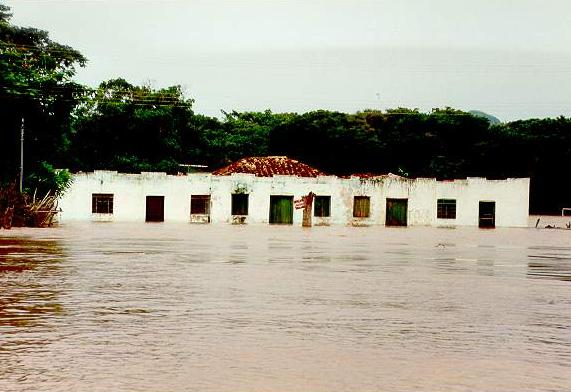
|
Fig. 1 Flood on the Cuiaba river, Mato Grosso, Brazil, on January 10, 1995.
A DIMENSIONLESS CONVECTION-DIFFUSION-DISPERSION
EQUATION OF FLOOD WAVES
Victor M. Ponce
[201214]
|
Abstract. The coefficients of the dimensionless partial differential equation of convection-diffusion-dispersion of flood waves are shown to be functions of the Froude and Vedernikov numbers only. The Froude number is the ratio of mean velocity to relative dynamic wave celerity. The Vedernikov number is the ratio of relative kinematic wave celerity to relative dynamic wave celerity. The third-order convection-diffusion-dispersion equation may be useful in the analysis of flood propagation problems where both diffusion and dispersion are significant. |
|
Qt + c Qx = ν Qxx +
η
Qxxx
| (1) |
in which Q = discharge, c = convective celerity,
ν = diffusion coefficient, and
The convective celerity, or flood wave speed, is defined as follows [Seddon, 1900; Chow, 1959]:
|
dQ
| (2) |
in which A = flow area.
The diffusion coefficient, or hydraulic diffusivity, for Chezy friction in hydraulically wide channels is [Dooge, 1973]:
|
qo F 2
| (3) |
in which qo = unit-width discharge, So = bottom slope, and F = Froude number, defined as follows [Chow, 1959]:
|
uo F = __________ (g Do)1/2
| (4) |
in which uo = mean velocity, Do = hydraulic depth, and g = gravitational acceleration.
The dispersion coefficient, or hydraulic dispersivity, is the following [Ferrick et al., 1984]:
|
yo η = F 2 ( ______ ) v 2So
| (5) |
Ponce [1991] has expressed the convective celerity as a function of the Froude and Vedernikov numbers, as shown by Eq. 6. The Vedernikov number is the ratio of relative kinematic and dynamic wave celerities [Craya, 1952].
|
V c = ( 1 + ____ ) uo F
| (6) |
Following Dooge et al. [1982], Ponce [1991] expressed the diffusion coefficient in terms of the Vedernikov number, in effect generalizing it for all friction types (turbulent Manning or Chezy, and laminar) and cross-sectional shapes, including hydraulically wide, triangular, and inherently stable [Ponce and Porras, 1995]:
|
qo ν = ______ ( 1 - V 2 ) 2 So | (7) |
in which [Dooge et al. 1982; Ponce 1991]:
|
V = ( β - 1 ) F
| (8) |
with β = exponent of the discharge-flow area rating Q = α Aβ.
Given qo = uoyo, and defining a reference channel length Lo = yo /So [Lighthill and Whitham, 1955], the diffusion coefficient is:
|
Lo ν = ( ____ ) uo ( 1 - V 2 ) 2
| (9) |
Furthermore, with Eq. 9, the dispersion coefficient is:
|
Lo η = ( ____ ) 2 uo ( 1 - V 2 ) F 2 2
| (10) |
3. DIMENSIONLESS CONVECTION-DIFFUSION-DISPERSION EQUATION
To nondimensionalize Eq. 1, we choose appropriate
dimensionless variables such that
|
Qt' + c' Qx' = ν' Qx'x' + η' Qx'x'x'
| (11) |
in which c' = dimensionless celerity:
|
V c' = 1 + _____ F
| (12) |
ν' = dimensionless diffusivity:
|
1 ν' = ___ ( 1 - V 2 ) 2
| (13) |
and η' = dimensionless dispersivity:
|
1 η' = ___ ( 1 - V 2 ) F 2 4
| (14) |
Therefore, the three coefficients of the dimensionless convection-diffusion-dispersion equation (Eqs. 12 to 14) are shown to be only functions of the Froude and Vedernikov numbers.
The online calculator ONLINEDISPERSIVITY.PHP
calculates the following wave properties:
(1) celerity,
(2) diffusivity, and (3) dispersivity.
4. SUMMARY
The coefficients of the dimensionless partial differential equation of convection-diffusion-dispersion of flood waves are shown to be functions only of the Froude and Vedernikov numbers. The Froude number is the ratio of mean velocity to relative dynamic wave celerity. The Vedernikov number is the ratio of relative kinematic wave celerity to relative dynamic wave celerity. The third-order convection-diffusion-dispersion equation may be useful in the analysis of flood propagation problems where both diffusion and dispersion are significant.
REFERENCES
Chow, V. T. 1959. Open-channel Hydraulics, McGraw-Hill. New York.
Craya, A. 1952.
The criterion for the possibility of roll wave formation. In Gravity Waves, Circ. 521, pp. 141-151, National Institute of
Standards and Technology, Gaithersburg, MD.
Dooge, J. C. I. 1973.
Linear theory of hydrologic systems: Chapter 9.
Technical Bulletin No. 1468,
327 pp., U.S. Department of Agriculture, Washington. D.C.
Dooge, J. C. I., W. B. Strupczewski, and J. J. Napiorkowski. 1982.
Hydrodynamic derivation of storage parameters of the
Muskingum model.
Journal of Hydrology, 54, 371-387.
Ferrick, M. G., J. Bilmes, and S. E. Long. 1984.
Modeling rapidly varied flow in tailwaters.
Water Resources Research, 20(2), 271-289.
Hayami, S., On the propagation
of flood waves. 1951.
Bulletin Disaster Prevention Reserach Institute,
Kyoto University. Japan, 1, 1-16.
Lightbill, M. J., and G. B. Whitman. 1955.
On kinematic waves. I.
Flood movement in long rivers. Proceedings of the
Royal Society of London, A, 229, 281-316.
Ponce, V. M. 1991.
New
perspective on the Vedernikov number. Water Resources
Research, 27(7), 1777-1779.
Ponce, V. M. and P. J. Porras. 1995.
Effect of cross-sectional shape on free-surface instability.
ASCE Journal of Hydraulic Engineering, Vol. 121, No. 4, April, 376-380.
Seddon, J. A. 1900.
River hydraulics. Transactions, American
Society of Civil Enginners, 43, 179-243.
| 201220 12:30 |